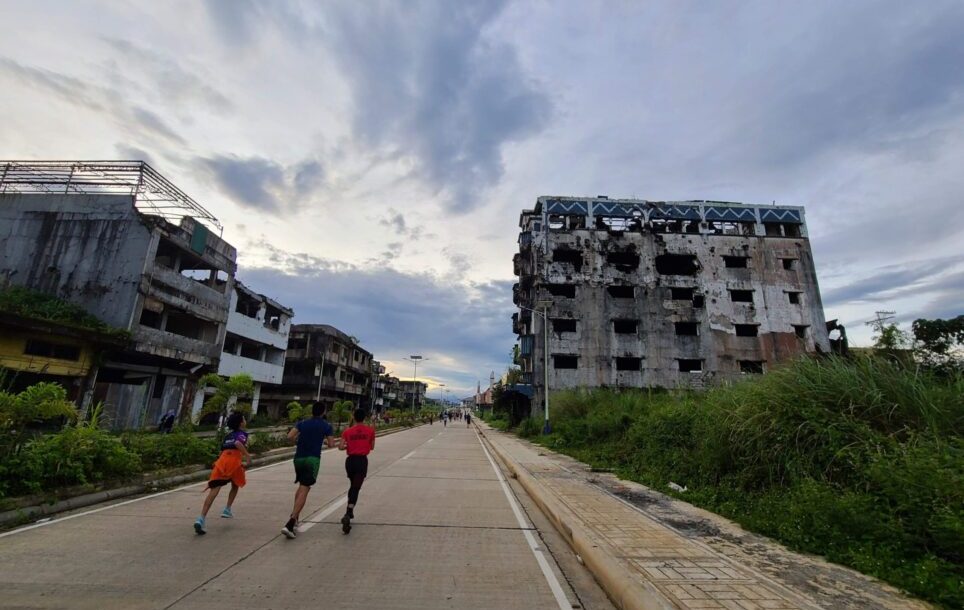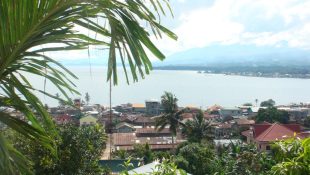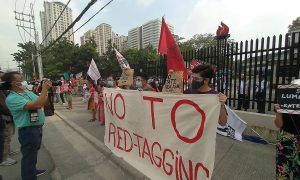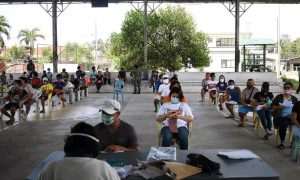On 23 May it will have been six years since the Maute group waved the Islamic State (IS) flag over the Islamic city of Marawi in the Philippines. The Maute group was a radical militant group, led by brothers and former Moro Islamic Liberation Front (MILF) members Omar and Abdullah Maute. President Rodrigo Roa Duterte immediately declared Martial Law on the whole island of Mindanao as the government forces exchanged fires with the militants and carried out airstrikes leaving the once thriving Muslim-majority city in ruins.
One of the authors, Raihan A. Yusoph, recalls that fateful day:
It was around 1 o’clock in the afternoon. I was roaming along Banggolo street, and it was bustling as usual. Many Mranaw locals were shopping in preparation for the holy month of Ramadan. It is still fresh in my mind how the militants suddenly started shouting “Myawma so katidawa!” which means “fighting [against Philippine government] has come!” They went house-to-house asking for men to join them. I went home and we secured our gate. We did not sleep that night. The following morning, my father decided to evacuate after learning from the authorities that they will bombard Marawi. My father insisted not to bring too many clothes and other belongings because he expected that we will return in three days anyway. This was his experience during the Marawi uprising of 1972. This is also the very reason why most of the Mranaws had the plan to return soon, but it never happened. We came home after more than five months, while others have been staying at temporary evacuation centres until now.
Mindanao is familiar ground to Islamic separatist groups attempting to establish an independent Islamic state, or caliphate, in the Philippines. Despite the familiarity of the threat that engulfed Marawi City, the military forces proved unprepared and ill-equipped for an organised urban terrorist attack of such scale. What is now known as the “Battle of Marawi” or the “Siege of Marawi” lasted five months, making it the longest urban warfare in the history of the Philippines. According to government reports, the siege claimed the lives of 920 militants, including the leaders of the IS groups, 165 soldiers, and 47 civilians, although these numbers are likely incomplete. It also forcibly displaced 360,000 people from the city and neighbouring municipalities.
Marawi City is an unfortunate illustration of how the nature of conflict is changing as well as the spaces where they take place. As civil wars have replaced inter-state armed conflicts, and armed insurgencies have moved outside remote jungles and isolated villages, cities are becoming the principal battleground.
Although urban warfare is not a new phenomenon, more recent conflicts have taken on an urban face—from gang violence to terrorist attacks. The increase in urban population has brought the consequences of conflict closer to people’s doorsteps. High urban density dispenses more means for those who incite armed violence, making their impact more widespread and the “enemies” less identifiable. With more civilians caught in the crossfire, urban conflicts have affected more innocent lives than traditional wars in ways that are not always visible. Given the urbanising nature of conflict, the need to urbanise conflict resolution and peacebuilding has been emphasised in peacebuilding scholarship. It is also important to consider the complex dynamics of urban environments during the peacebuilding process and the role of urban spaces in either facilitating reconciliation or reifying division.
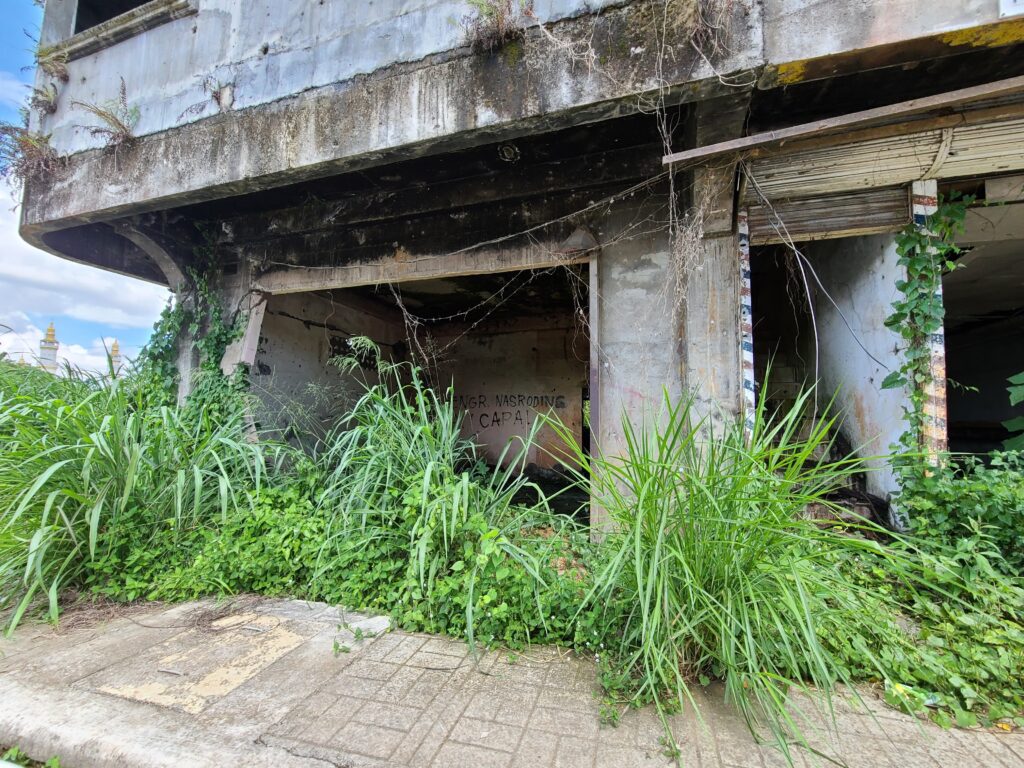
Land ownership is one of the issues that prevent many of the displaced families from returning home (Photo: author)
The urban geography of conflict and peace
When building peace, it is imperative to ask where peace and conflict take place. During the siege of Marawi, several sites that were tactically crucial to the objectives of the militants were prioritised for the military’s takeover. The Grand Mosque, the Bato Mosque, the St. Mary’s Cathedral and the Padian (or Grand Market) were used by the militants as logistics hubs and hostage locations. The militants occupied the minarets of the mosques to serve as sniper nests overlooking the three bridges (Banggolo, Mapandi, and Raya Madaya) that connect to the centre of Marawi City.
Mounting Maranao frustration could cause further radicalisation after military operations end.
Rebuilding Marawi, or rebuilding extremism?
The militants’ occupation of the religious sites also sent a strong message to the people of Marawi. Many Muslims condemned the desecration of the mosques, labelling the militants as terrorists acting outside Islamic teachings. The decapitation of religious figures inside the cathedral also signalled the militants’ contempt toward the city’s Christian minority. The militants recorded the destruction and desecration of the cathedral and shared the footage in their propaganda videos. One of the hostages held in the Cathedral shared her encounter with the militants. She recalled her sadness when Omar Maute showed them a video of Marawi’s destruction and described it as the history of Marawi. “If Omar connected [the siege] to Marawi’s history, then [I am] not a part of that history,” she said.
What happened in Marawi demonstrates that violence is not just spatial but also visual, and that post-conflict reconstruction efforts need to consider the role of spaces and images in building peace.
Walking along the deserted streets of Marawi City, it is difficult to imagine that it was once a thriving trading centre. The newly rebuilt mosques stand in stark contrast to the residential lots covered with overgrown shrubs and moss-covered walls spray-painted with the surnames of the families, marking the homes where they plan to return. It was reported in July 2022 that approximately 16,749 displaced families are yet to return.
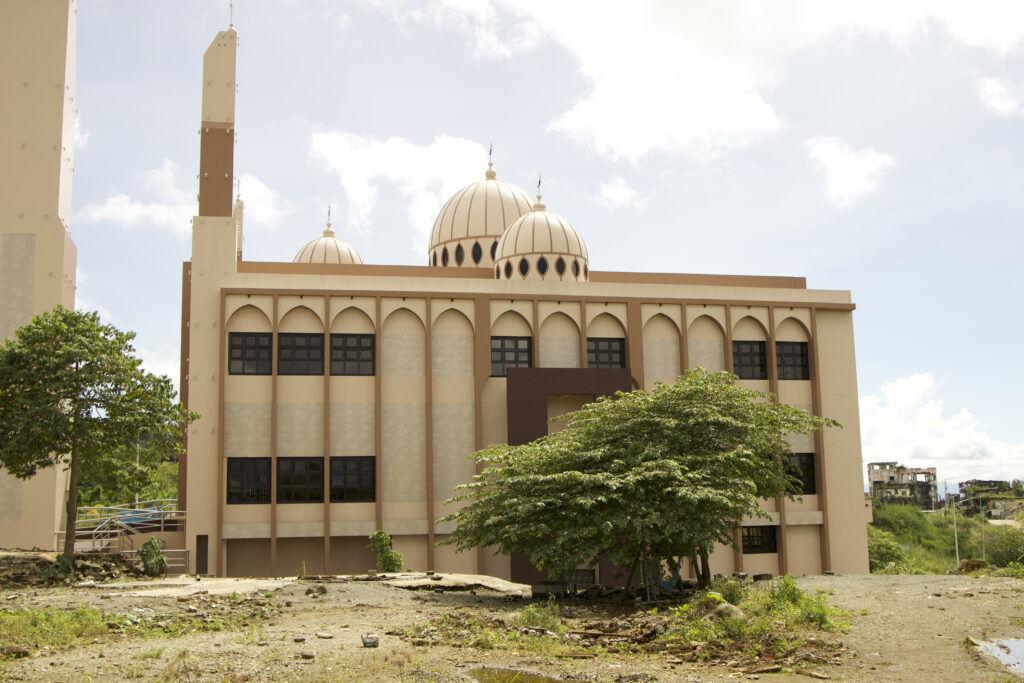
The new Bato Mosque takes on a different architectural design. (Photo: author)
Every break of dawn, the war-torn atmosphere of Marawi City gives in to the presence of morning joggers entering the Banggolo bridge toward Gomisa Avenue. Towering above the destruction along this widened and newly paved avenue is the Bato mosque. With its sharp shapes and brown and golden shades, the mosque is unrecognisable without the rounded roofs and green and white paint that used to characterise the mosques of Marawi.
The reconstructed Grand Mosque, or Jameo Mindanao Al-Islamie Islamic Center, also takes the new colour scheme. While some Mranaws prefer to preserve the original designs of these mosques, Alim Abdulmajeed Djamla, the resident imam of the Grand Mosque, explained during our interview that the change of colour was consulted with and approved by Muslim donors from overseas. Task Force Bangon Marawi (TFBM) Assistant Secretary Felix Castro, Jr. also confirmed that the rehabilitation of Marawi, including the reconstruction and rebuilding of mosques, was done in consultation with local (elected) representatives. However, there are still criticisms of the lack of consultation with non-elites in terms of identifying the priorities for rehabilitation and designing the government’s projects. This issue is prevalent in post-conflict settings in which local participation is often compromised against the urgency of rebuilding.
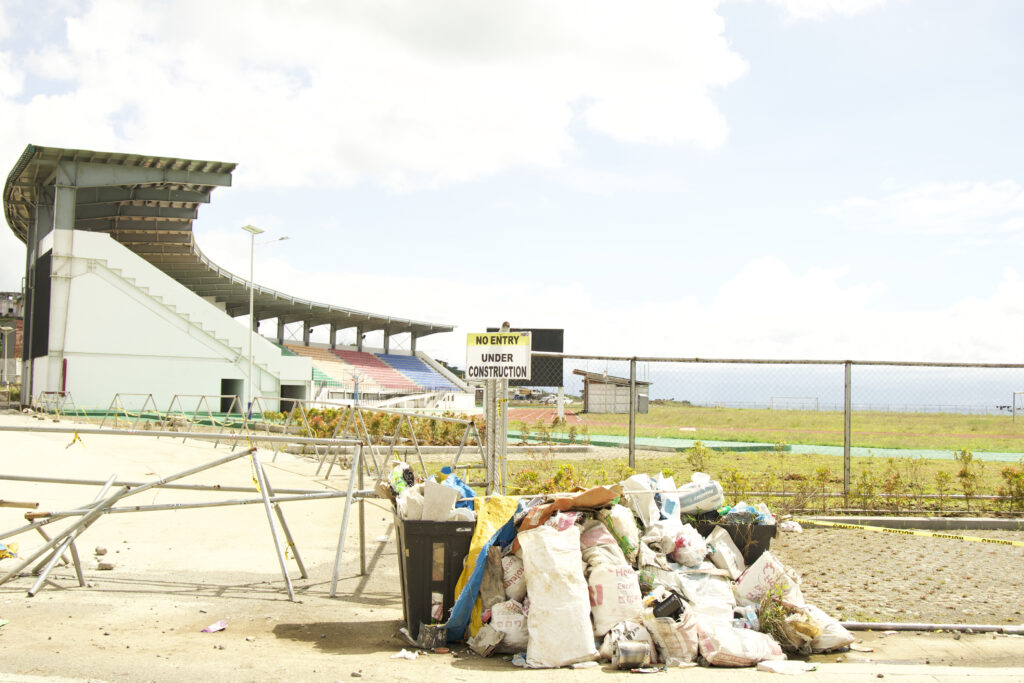
The new Sarimanok Sports Stadium. (Photo: author)
The new buildings of Marawi City are shiny but empty. While the rebuilding of selected urban sites has been completed, many of them are still publicly inaccessible. When asked why the morning joggers are not using the Sarimanok Sports Stadium, a maintenance staff answered that proper running shoes are required on the stadium grounds. Instead of runners, the tracks are manned by armed personnel.
Some of the joggers whom we talked to in front of the Bato mosque lamented the fact that the mosque remains closed for prayers. “The mosque is used only during Islamic feast prayers but not for congregational prayers; for our daily prayers, we are not allowed in there, and I don’t know the reason why,” said one of them. This contributes to the perception that the government-led rehabilitation is slow, inadequate, and exclusive of the ordinary people. According to another Mranaw, “[They] heard that the rehabilitation received a lot of funding, but [they] don’t know why the implementation is inadequate. The roads are now completed, but the traffic lights are not functioning. Even the electricity and water systems are incomplete; [they] only see cable wires and water pipes.”
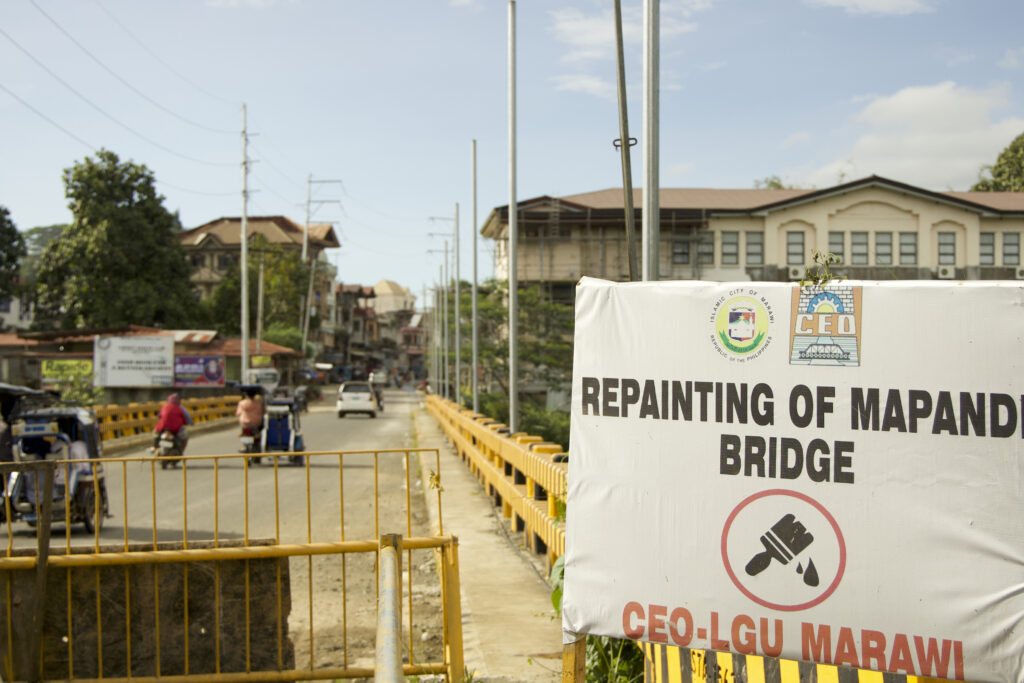
Traffic flows through the newly painted Mapandi Bridge. (Photo: author)
Before the battle, urban sites were integrated into the everyday life of Mranaws. The bridges, for instance, are manifestations of the city’s economic development. Before the construction of the bridges, the people used lansa, or small boats, to transport goods across the Agus river. As the city grows, roads and bridges were built to make transportation more convenient. These developments contributed to Marawi being the trading hub for the Islamic provinces of Mindanao. Specifically, the Padian served as the commercial centre for traditional textiles, delicacies, and antiques, among other Mranaw products. As the locals say, “di ka ma Mranaw o da ka makadapo sa Padian” (“You are not a Mranaw if you have not set foot at Padian”), symbolising the economic and cultural significance of the site.
Transformed into a Peace Memorial Park, the Padian is now unrecognisable without the small shops and network of bustling lanes. Instead of reinstalling the public market, a three-story shopping mall was built. The “tuwak-a-lapot” (sandy stairs) and “tuwak-a-bata” (concrete stairs), former landmarks and entryways to Padian, now lead to a newly built statue of the national hero, Jose Rizal, decked between the newly constructed Peace Museum and School of Living Traditions. When we visited the area in December 2022, both establishments were still closed to the public. The bullet-holed minaret remnant of the Bato mosque is installed in front of the Peace Museum. But for some of the park’s visitors we talked to, the minaret is anything but a symbol of peace. Instead, it is a symbol of war and sorrow. For most Mranaws living in Marawi City, the minaret and the peace museum are visual reminders of painful memories. And for some, displaying the minaret in a way that looks like a tourist attraction for outsiders is an act of disrespect to the mosque and to their faith.
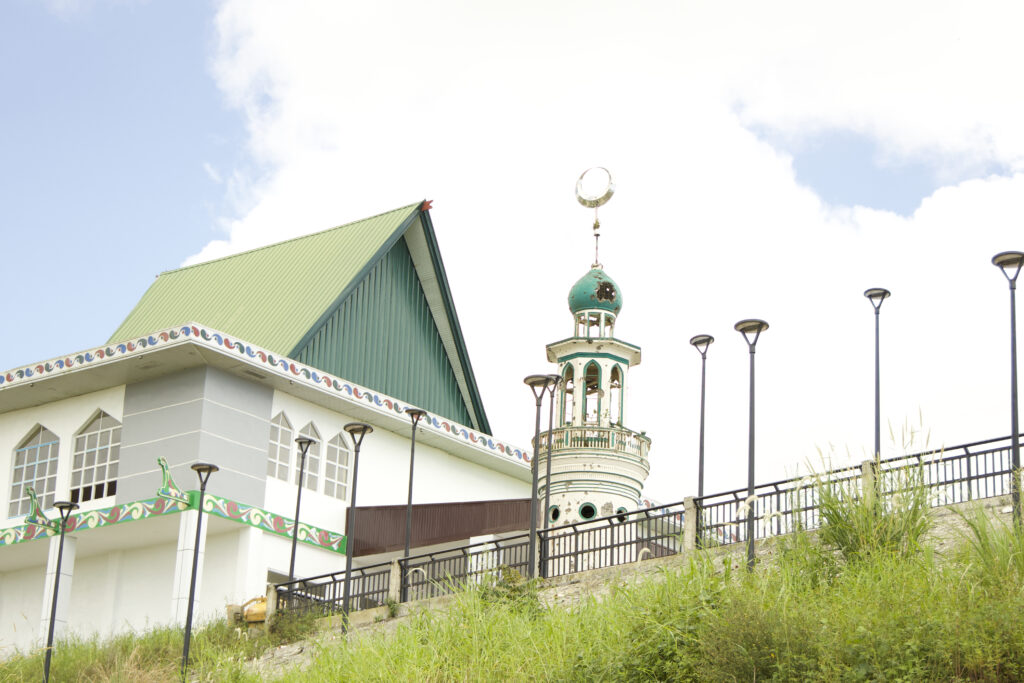
The remnant of the Bato mosque installed in front of the new Peace Museum (Photo: author)
Building back worse
The conversations we had during our visit to Marawi City suggest that during the rebuilding process, the sites became instrumental to the government’s narrative of peace and development, often sidelining the needs and views of ordinary people. Early on there were criticisms against having a Convention Centre, which many Mranaws view as unnecessary and not as important as the facilitation of the people’s return to their homes. Focusing on grand infrastructure projects alone left ongoing issues related to displacement, compensation, and other socioeconomic challenges unaddressed. As one of our Mranaw interviewees said, “The government projects are good, but I’m hoping that the people can come back to their homes.”
Urban conflict requires peacebuilding that is relevant to urban contexts and inclusive of ordinary people. To assist researchers and practitioners in understanding the physical and symbolic transformation of these sites, we launched a geoportal that serves as a repository of the geolocations, photographs, videos, and written and oral narratives about the key urban sites from the Marawi siege. We will continue updating the geoportal with more recent information not just of Marawi City but also of other urban cases of post-conflict rebuilding.
As the city observes the annual Marawi Week of Peace, symbolising the government’s continued commitment to rehabilitating Marawi into a “peaceful and prosperous city,” it is important to be reminded of the need to integrate the historical and cultural significance of the urban sites being rebuilt in Marawi. Peace is not just an abstraction; it is a real aspiration, especially for people coming out of the trauma of violent conflicts. And for peacebuilding to take root, the spaces where conflict happened must be transformed into places of peace, justice, and reconciliation for the people who live in and give meaning to them.
 Facebook
Facebook  Twitter
Twitter  Soundcloud
Soundcloud  Youtube
Youtube  Rss
Rss 